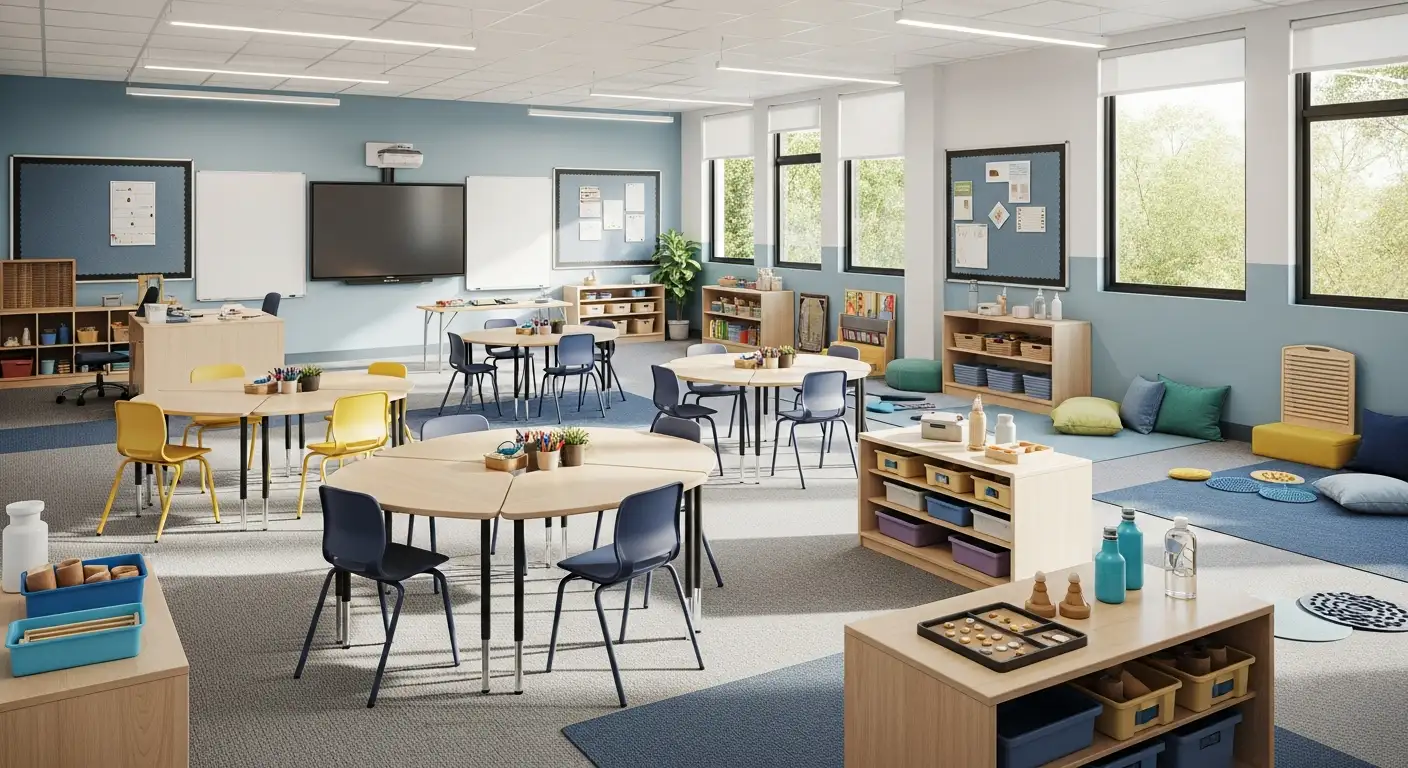Understanding Sensory-Seeking and the Role of ABA
Sensory-seeking behaviors are common in children, especially those with autism or sensory processing challenges. These behaviors arise when children actively seek additional sensory input to regulate their sensory system. Applied Behavior Analysis (ABA) offers a structured, personalized approach to help children manage these behaviors, enhance their sensory processing, and improve overall functioning.
The Impact of Sensory Processing on Children
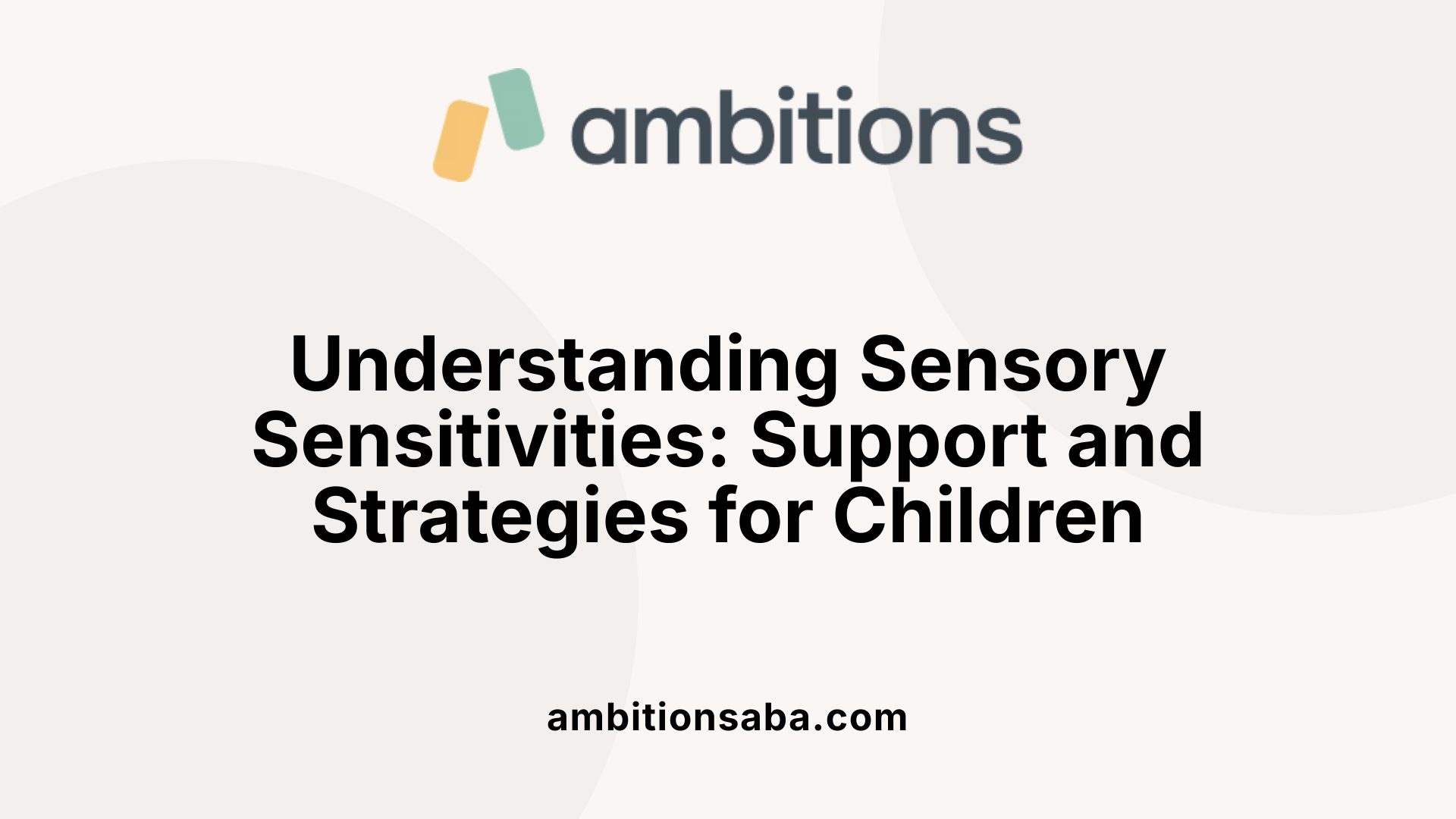
How does sensory processing affect children, and what are common sensitivities?
Sensory processing plays a crucial role in how children perceive, interpret, and react to their environment. It directly influences their behavior, emotional regulation, and ability to engage in daily activities. When sensory processing is typical, children can smoothly respond to stimuli like sounds, sights, textures, and movements, allowing them to learn and interact comfortably.
However, many children experience sensory sensitivities that can significantly impact their behavior. These sensitivities are often categorized into hypersensitivity and hyposensitivity.
Children with hypersensitivity (or over-responsiveness) react intensely to sensory input. For example, they might cover their ears in loud environments, avoid bright lights, or refuse to wear certain clothing textures. Such reactions can lead to behaviors like withdrawal or meltdowns.
In contrast, children with hyposensitivity (or under-responsiveness) seek additional sensory input. They may bump into objects, touch everything excessively, or prefer fast, intense movements to meet their sensory needs.
Common sensitivities include:
| Sensory Domain | Typical Reactions | Possible Behaviors | Associated Conditions |
|---|---|---|---|
| Visual | Bright lights, flashing screens | Covering eyes, avoiding visual stimuli | Autism Spectrum Disorder (ASD), ADHD |
| Tactile | Certain textures, clothing tags | Avoiding textures, selective touch | ASD, sensory processing disorder |
| Auditory | Loud noises, busy environments | Covering ears, withdrawal | ASD, hyperacusis |
| Vestibular (movement) | Spinning, swinging | Seeking motion, difficulty with balance | ASD, sensory integration issues |
| Proprioceptive (body awareness) | Heavy pressure, crashing | Bumping, craving deep pressure | ASD, ADHD |
| Taste and Smell | Strong flavors, scents | Food selectivity, aversion | ASD, food sensitivities |
Recognition of these sensitivities and understanding their influence on behavior allows caregivers and therapists to develop tailored strategies. These include sensory diets, sensory-friendly environments, and therapeutic interventions like sensory integration therapy. Addressing these sensitivities can help children manage their reactions, increase their comfort, and improve participation in everyday activities.
The Central Role of ABA in Sensory Processing Support
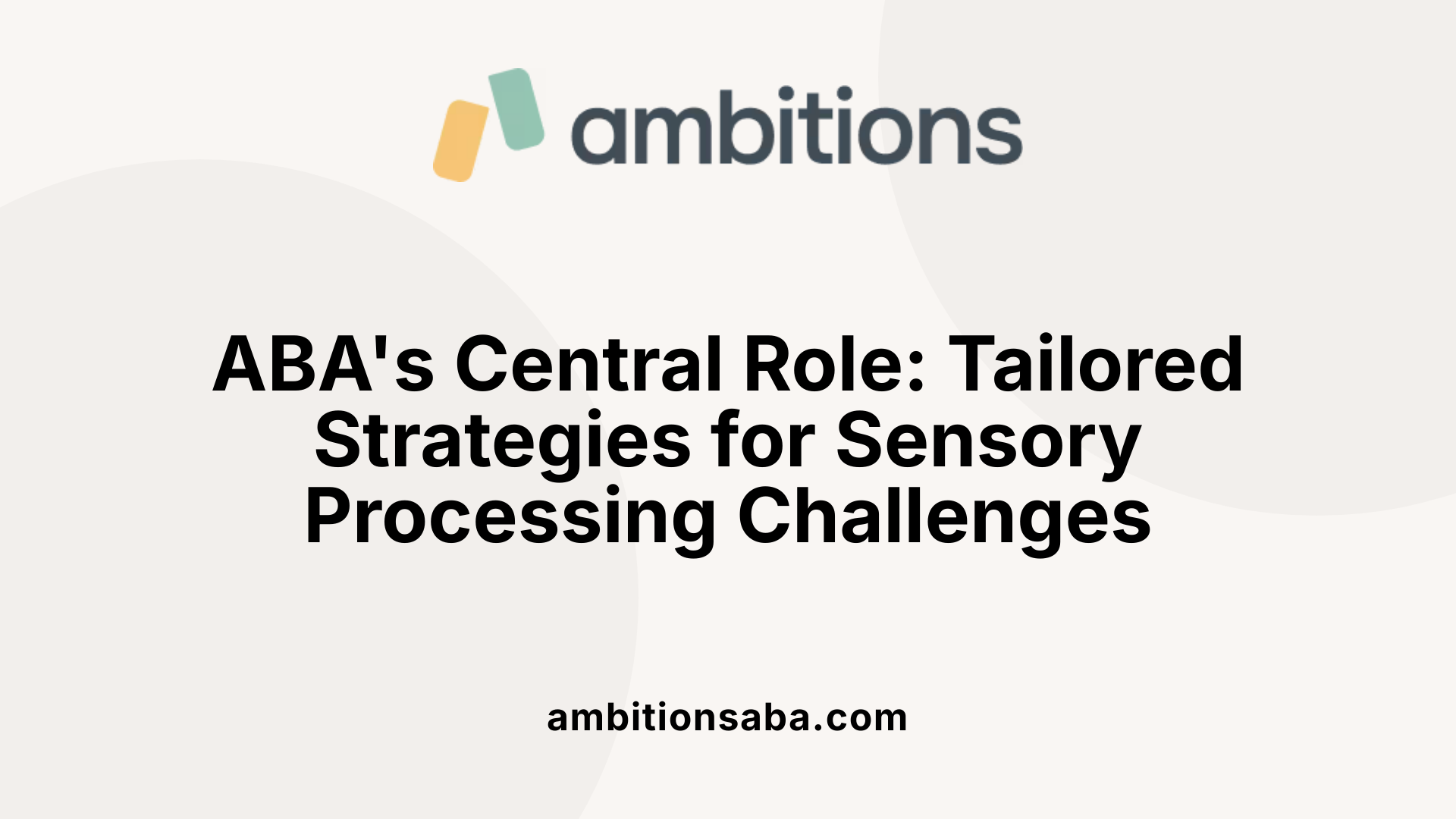
What is the role of ABA in supporting children with sensory processing issues related to autism?
Applied Behavior Analysis (ABA) is a structured and evidence-based approach that is highly effective in assisting children with sensory processing challenges, especially those on the autism spectrum. ABA focuses on understanding how children respond to sensory stimuli and then developing tailored strategies to help them manage sensory sensitivities.
One primary goal of ABA is to teach children coping skills that enable them to handle sensory overloads better. Techniques such as desensitization involve gradually introducing children to sensory stimuli like loud sounds or different textures, starting from less intense experiences and slowly increasing exposure. This approach helps build tolerance over time.
Sensory diets are personalized plans that include activities such as heavy work exercises or calming sensory inputs like weighted blankets and soothing textures. These are incorporated into daily routines to promote focus and calmness.
Creating sensory-friendly environments is another critical component. This includes minimizing clutter, controlling lighting, reducing noise with tools like sound absorbers, and designating calm spaces where children can retreat if overwhelmed.
ABA therapy also teaches children specific coping strategies, including deep breathing exercises, the use of visual supports, and sensory toolboxes stocked with items like sensory toys, fidget tools, or noise-canceling headphones. These tools and techniques help children regulate their emotions and manage sensory overload.
Therapists utilize assessments such as Functional Behavior Assessments (FBAs) to determine if behaviors are linked to sensory sensitivities. Using this information, they can design targeted interventions that promote positive alternatives, like structured movement breaks instead of disruptive stimming behaviors.
Data collection plays a vital role in ABA’s effectiveness. Ongoing monitoring of progress allows therapists to modify interventions based on each child's evolving needs, ensuring that strategies remain relevant and effective.
Collaboration with families and educators is also essential. Consistent application of sensory strategies across home, school, and therapy settings helps reinforce progress and provides children with stable support systems.
Overall, ABA’s flexibility and focus on personalized intervention enable children to develop better emotional regulation, reduce problematic behaviors, and participate more fully in daily activities. This comprehensive approach fosters independence and improves quality of life.
How does ABA tailor interventions through collaboration with families?
Integrating input from families allows therapists to understand each child's sensory preferences, sensitivities, and triggers. Parents and caregivers share observations and insights, which help in designing effective, personalized strategies.
Collaborative planning includes educating families about sensory processing and involving them in implementing sensory diets, behavioral strategies, and environmental modifications. Such cooperation ensures consistency and reinforcement of skills across various settings.
Regular coaching sessions and updates enable families to adapt strategies as children's sensory needs change over time. This dynamic approach promotes sustained progress.
How is progress monitored and strategies adapted over time?
ABA therapy relies heavily on systematic data collection to track behavioral and sensory responses. Therapists analyze this data to evaluate the effectiveness of interventions.
If progress plateaus or regressions occur, strategies are reviewed and modified. For example, if a child responds better to certain sensory tools or activities, these are integrated more frequently.
This iterative process ensures interventions remain relevant and effective, accommodating the child's developmental trajectory and sensory profile evolution.
By maintaining a flexible, evidence-based approach and fostering strong collaboration with caregivers, ABA therapy can continuously support children in managing sensory issues, ultimately leading to increased engagement, emotional stability, and adaptive behaviors.
Understanding and Addressing Sensory-Seeking Behaviors with ABA
How does ABA therapy address sensory-seeking behaviors in children?
ABA therapy approaches sensory-seeking behaviors through a comprehensive, individualized process that begins with identifying the child’s specific sensory needs and understanding the function of these behaviors. Therapists conduct thorough assessments, such as Functional Behavior Assessments (FBAs), to determine whether behaviors serve sensory purposes, such as seeking stimulation or self-regulation.
Once the behaviors are understood, interventions focus on teaching replacement behaviors that meet the same sensory needs in a more adaptive manner. For example, a child who seeks intense tactile input through disruptive stimming might be encouraged to use sensory toys like textured fidgets or engage in structured sensory activities, such as swinging or weighted blanket use. Positive reinforcement is a central strategy, rewarding children when they choose or engage in these alternative behaviors.
Incorporating sensory strategies like sensory diets — personalized plans involving activities such as heavy work, calming sensory input, or proprioceptive exercises — helps children regulate their responses to sensory input. These activities can be integrated into therapy sessions or home routines, promoting consistent support across environments.
Gradual desensitization techniques play a vital role for children with hypersensitivities, helping them slowly become accustomed to stimuli they find overwhelming, such as loud noises or certain textures. Through controlled exposure, children learn to tolerate sensory input without engaging in disruptive behaviors.
Overall, ABA combines behavioral methods with sensory integration strategies to create supportive, tailored environments. These approaches aim not only to reduce problematic sensory-seeking behaviors but also to foster emotional regulation, social skills, and independence.
How are assessment tools like FBAs used in this context?
Functional Behavior Assessments (FBAs) help pinpoint whether sensory-seeking behaviors are functionsally driven—meaning the child engages in these actions to fulfill sensory needs. The results guide therapists to design targeted interventions that address the root cause.
How does ABA involve replacement behaviors and reinforcement?
Replacing problematic sensory-seeking actions with suitable, functional behaviors is a cornerstone of ABA. For example, substituting disruptive stimming with activities that provide appropriate sensory input encourages children to develop other ways to self-regulate.
Reinforcement techniques, such as positive reinforcement, underpin these strategies by rewarding desirable behaviors, such as asking for a break or using sensory tools. This not only strengthens adaptive responses but also promotes generalization of these skills into daily routines.
| Approach | Description | Examples |
|---|---|---|
| Sensory Diets | Personalized activity plans for sensory regulation | Heavy work, calming activities |
| Replacement Behaviors | Teaching functional alternatives | Using sensory toys instead of disruptive stimming |
| Reinforcement | Reward-based encouragement | Praise, tokens, preferred activities |
| Gradual Desensitization | Stepwise exposure to sensitive stimuli | Tolerating touch or noise gradually |
| Sensory Integration Activities | Structured sensory play | Swing therapy, tactile activities |
Final thoughts
Addressing sensory-seeking behaviors with ABA involves detailed assessment, strategic replacement, and reinforcement, all tailored to each child's sensory profile. Combining behavioral techniques with sensory strategies creates a supportive environment that reduces problematic behaviors and promotes overall well-being. This integrated approach not only manages behaviors but also enhances emotional regulation, social engagement, and independence, setting the stage for more adaptive and functional skills over time.
Strategies and Techniques within ABA to Manage Sensory-Seeking Behaviors
What strategies, techniques, and tools does ABA use to manage sensory-seeking behaviors?
Applied Behavior Analysis (ABA) offers a comprehensive range of strategies to help children manage sensory-seeking behaviors. One fundamental approach involves creating sensory-friendly environments. This means designing spaces that reduce sensory triggers such as excessive noise, bright lights, or clutter. Using tools like noise-canceling headphones, dimmable lighting, and organized spaces helps minimize sensory overload.
In addition, ABA incorporates sensory diets—personalized plans that include activities like heavy work exercises, calming sensory input, and the use of fidget tools. These sensory diet activities are tailored to each child's preferences and sensory needs, helping them self-regulate and stay focused.
Implementing sensory breaks is another crucial technique. Short periods of structured sensory activities, such as swinging, deep pressure, or tactile play, provide children with a controlled way to satisfy sensory cravings without disruptive behaviors. These breaks can be scheduled or used during moments of escalating sensory-seeking actions.
Teaching children coping skills is central to ABA's approach. Skills like deep breathing, using visual supports, and creating sensory toolboxes equip children with methods to manage sensory overload. Visual supports—including visual schedules and picture cards—help children understand upcoming sensory experiences, reducing anxiety and improving compliance.
Reinforcement strategies are used extensively in ABA. When children engage in appropriate sensory activities or demonstrate self-regulation, positive reinforcement encourages these behaviors. For example, awarding praise or preferred items for calm responses reinforces adaptive coping mechanisms.
Collaboration with caregivers and occupational therapists enhances the effectiveness of these interventions. Caregivers learn to implement sensory strategies at home, maintaining consistency across environments. Sensory tools, such as textured toys, weighted blankets, or therapy swings, support sensory regulation outside of therapy sessions.
In summary, ABA's multifaceted toolkit—including environmental modifications, sensory diets, behavioral reinforcement, and visual supports—works together to help children develop tolerance to sensory stimuli, reduce seeking behaviors, and build emotional resilience.
Combining ABA and Sensory Integration Therapy for Optimal Support

Can ABA be integrated with sensory integration therapy to support children with sensory processing challenges?
Yes, ABA can be effectively combined with sensory integration therapy to provide comprehensive support for children facing sensory processing difficulties. This hybrid approach harnesses the structured, reinforcement-based strategies of ABA along with sensory-focused activities, creating a tailored intervention that addresses both behavioral and sensory needs.
ABA, or Applied Behavior Analysis, uses techniques such as reinforcement, task analysis, and differential reinforcement to modify behaviors and teach new skills. When integrated with sensory strategies, ABA can help children develop better responses to sensory stimuli, decrease problematic behaviors, and increase engagement in everyday activities.
Sensory integration activities—like tactile play, vestibular exercises, and auditory processing tasks—are incorporated within ABA sessions to enhance sensory regulation and emotional control. For example, children might receive positive reinforcement for tolerating a sensory stimulus or for engaging in a calming sensory activity.
This combined method allows therapists to systematically address sensory behaviors—like sensory-seeking actions or sensitivities—by applying desensitization protocols or sensory diets alongside behavioral interventions. The goal is to improve the child's ability to process sensory information more efficiently, leading to better emotional regulation, increased social interaction, and greater independence.
Research suggests that children benefit from this integrated approach, experiencing improved participation in educational and social settings, as well as a reduction in sensory-related problem behaviors. However, while initial findings are promising, further studies are necessary to fully establish the long-term advantages of combining ABA with sensory integration therapy.
Overall, this versatile approach supports a holistic developmental path, emphasizing individual preferences and sensory profiles to create effective, personalized interventions. The collaboration among therapists, caregivers, and educators ensures strategies are consistent across environments, fostering meaningful progress for children with sensory processing challenges.
Sensory-Friendly Environment Creation and Tools
Designing sensory-friendly spaces
Creating a sensory-friendly environment involves thoughtful adjustments to a child's surroundings to minimize sensory overload and promote comfort. This includes reducing clutter to limit visual distractions and controlling lighting levels to avoid harsh or flickering lights that can trigger sensitivities.
In addition, specific designated calm spaces or quiet zones are essential. These areas serve as refuges where children can retreat when overwhelmed, helping them regulate their emotions and sensory input.
Using sensory toys, weighted blankets, noise-canceling headphones
A variety of tools support children in managing sensory sensitivities. Sensory toys such as textured balls, chewable necklaces, and fidget devices provide tactile stimulation or calm the nervous system.
Weighted blankets and lap pads offer calming proprioceptive input, helping children feel more grounded and secure. Noise-canceling headphones or earplugs are effective for children sensitive to auditory stimuli, reducing background noise and preventing sensory overload.
These tools not only provide comfort but also encourage self-regulation skills and independence in managing sensory input.
Environmental modifications to reduce triggers
Modifying the environment is crucial in supporting children with sensory processing issues. Strategies include:
| Environmental Adjustment | Description | Purpose |
|---|---|---|
| Minimize clutter | Reduce visual clutter and organize materials neatly | Less visual distraction and stress |
| Control lighting | Use soft, natural, or adjustable lighting options | Avoid harsh or flickering lights |
| Noise reduction | Implement sound-absorbing materials, soft furnishings, or noise barriers | Reduce auditory overload |
| Calm spaces | Designate specific areas with calming colors and minimal sensory input | Provide refuge for self-regulation |
These modifications aim to create a predictable, peaceful environment that supports sensory regulation and reduces potential triggers.
Supporting tools for sensory management
Along with physical modifications, integrating sensory tools into daily routines can significantly improve a child's comfort and engagement. Useful tools include sensory beds for deep pressure input, textured mats, and swings for vestibular input. Visual supports, such as schedules or timers, help children anticipate transitions, reducing anxiety.
By combining personalized sensory tools with environmental modifications, caregivers and therapists can help children navigate sensory challenges more effectively. This integrated approach fosters emotional regulation, promotes positive behaviors, and allows children to participate more fully in daily activities and learning experiences.
Practical tips for implementation
- Conduct assessments to identify specific sensory sensitivities.
- Involve children and caregivers in designing spaces and selecting tools.
- Regularly update and adapt the environment as sensory needs evolve.
- Use positive reinforcement to encourage the use of sensory tools and participation in sensory activities.
Together, these strategies create a supportive, sensory-friendly environment that empowers children to manage their sensitivities with greater ease, leading to improved well-being and development.
The Importance of Continuous Learning and Personalization in ABA
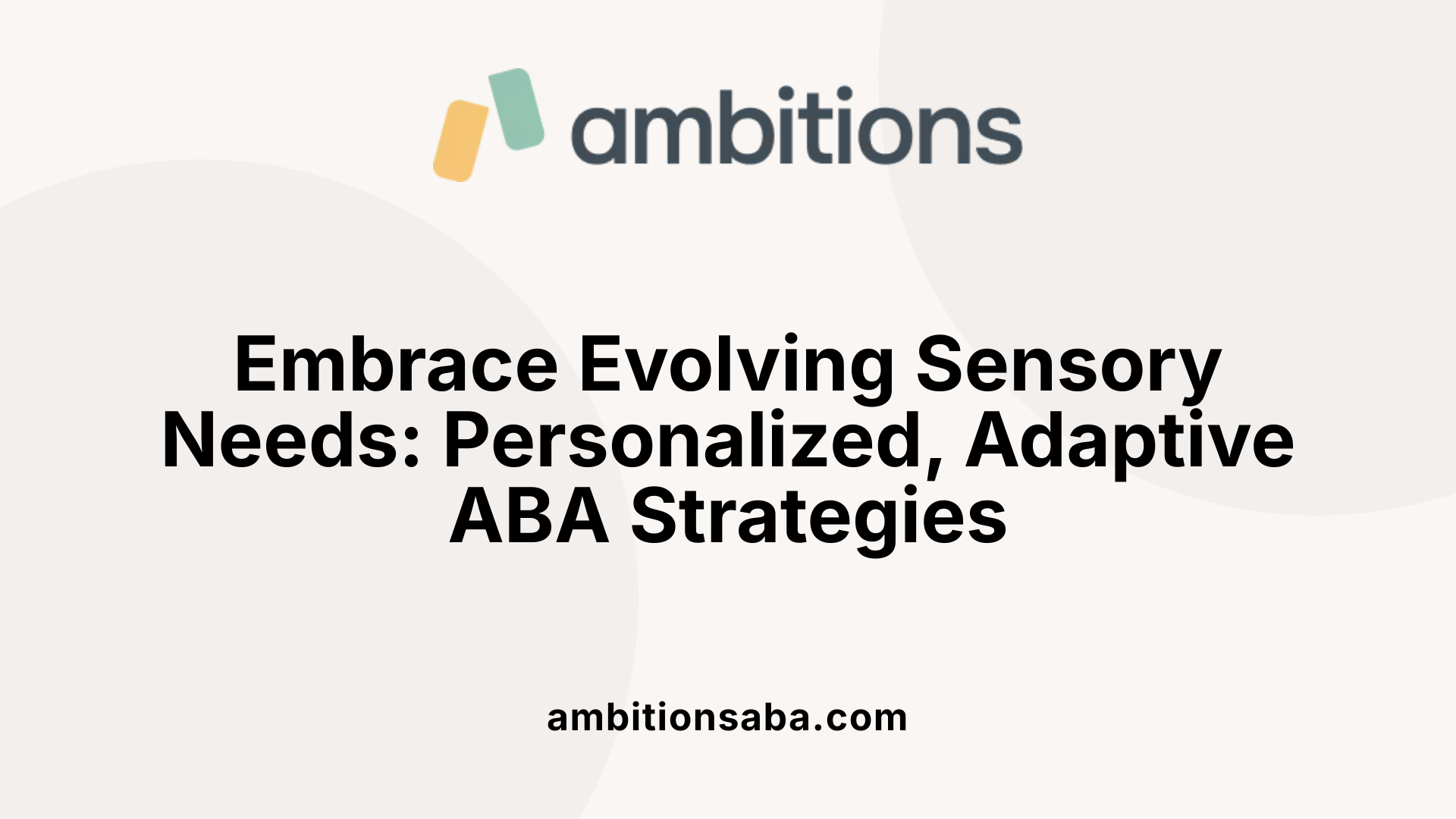
How does ABA therapy address changing sensory needs over time?
ABA therapy recognizes that sensory needs are not static; they evolve as children grow and develop. To effectively support these changing needs, ABA employs a flexible, ongoing process of assessment and adaptation.
Therapists continually monitor a child's progress by collecting detailed data on behavioral responses, sensory sensitivities, and coping strategies. Through regular evaluations, they can identify new sensory triggers or shifts in preferences.
Collaboration with families is crucial in this process. Parents and caregivers provide insights about daily challenges and successes, enabling therapists to tailor interventions more precisely.
Interventions such as sensory diets—personalized plans involving activities like heavy work, calming sensory input, or movement breaks—are adjusted based on current needs. These modifications might include introducing new sensory tools, changing the environment, or teaching updated coping strategies.
Therapists also incorporate techniques like desensitization, gradually exposing children to sensory stimuli they find overwhelming to build tolerance over time. This gradual approach helps reduce sensory overload and promotes emotional regulation.
Furthermore, environmental modifications—such as reducing clutter, controlling lighting, or creating calm spaces—are routinely reviewed and refined to align with the child's developing sensory profile.
This continuous learning process ensures that ABA therapy remains relevant and effective, supporting long-term skill development. It helps children better manage sensory challenges and adapt to new situations, fostering independence and emotional resilience.
| Aspect | Approach | Purpose |
|---|---|---|
| Ongoing Assessment | Data collection, regular reviews | Detect changes in sensory needs |
| Family Collaboration | Regular communication | Incorporate insights and preferences |
| Environment Modification | Dynamic adjustments | Minimize sensory triggers |
| Sensory Diets | Personalized, updated | Support regulation and focus |
| Desensitization Techniques | Gradual exposure | Increase tolerance |
| Intervention Flexibility | Tailoring strategies | Ensure relevance and effectiveness |
Treatment plans are thus fluid, adaptable, and highly personalized—reflecting the understanding that addressing sensory needs is a lifelong, evolving journey. This approach not only enhances immediate comfort and participation but also promotes resilience as children encounter new environments and challenges.
Training and Empowering Caregivers and Educators
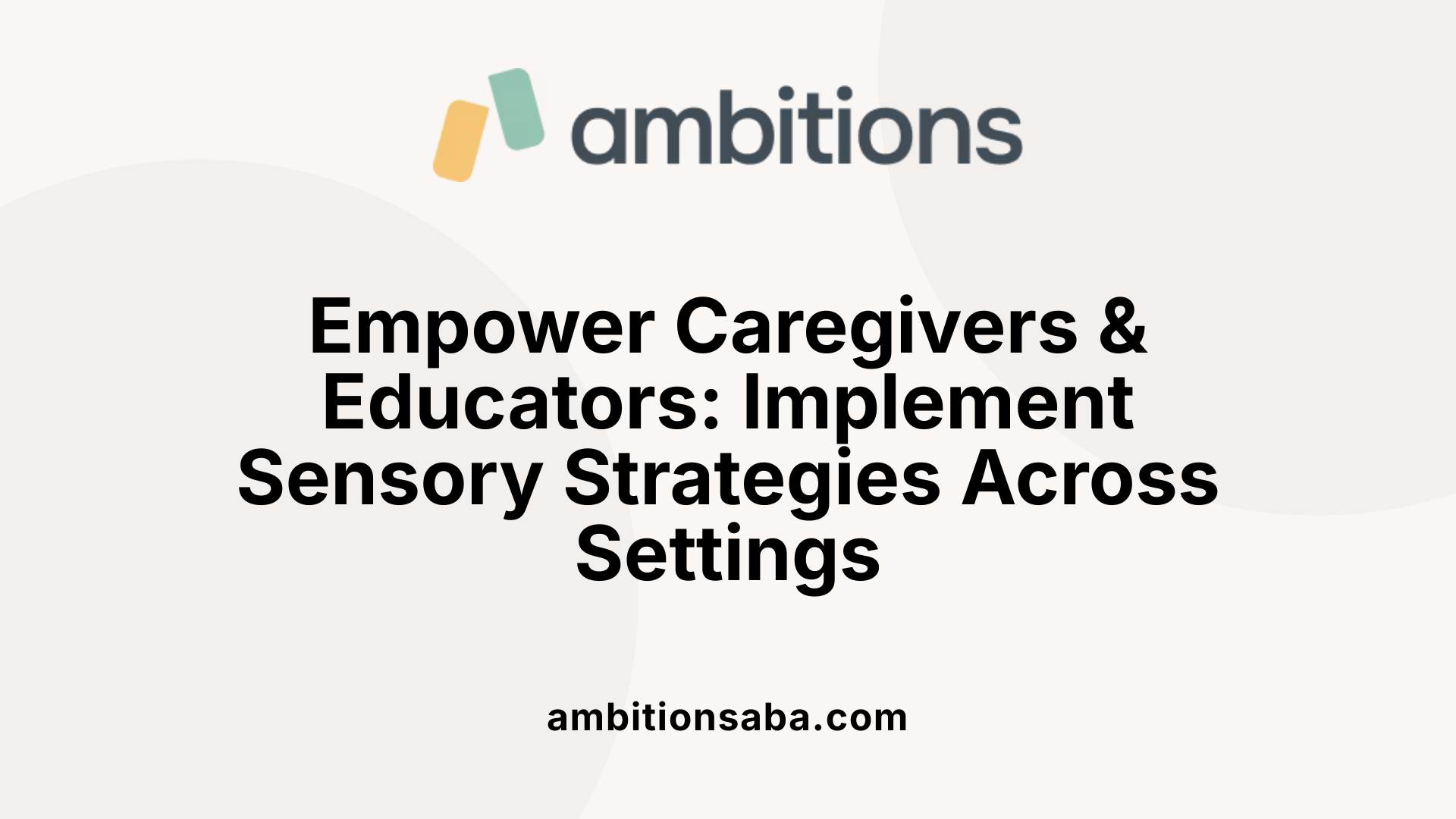
How can caregivers and educators support children with sensory processing challenges within ABA frameworks?
Supporting children with sensory sensitivities through ABA involves more than direct therapy sessions; it emphasizes empowering those who interact with the child daily. Training caregivers and educators is essential for extending sensory strategies beyond clinical settings into home and school environments.
One of the core aspects is providing targeted training and resources. Therapists often work closely with families and teachers to educate them on sensory triggers and effective intervention techniques. This includes demonstrating how to implement sensory-friendly routines, such as incorporating sensory breaks, using calming tools, and creating structured environments that reduce sensory overload.
Ongoing support plays a vital role. Regular coaching sessions, educational materials, and practical demonstrations help caregivers and teachers stay confident and consistent in applying strategies. This continuous learning encourages them to tailor interventions to meet evolving sensory needs and daily routines seamlessly.
Collaboration among therapists, families, and educators ensures strategies are personalized and integrated across all settings. Sharing insights about what sensory activities help a child stay focused or calm facilitates better reinforcement and reduces behavioral challenges.
Supporting children with sensory processing challenges involves teaching them coping mechanisms like asking for visual or sensory breaks, using weighted blankets, or engaging in proprioceptive activities such as swinging or heavy work tasks. When caregivers and teachers understand and effectively implement these techniques, they significantly improve the child's emotional regulation, social interactions, and overall participation.
In summary, training and empowering caregivers and educators involves providing them with knowledge, practical tools, and ongoing support. This collaborative approach ensures consistent, sensory-friendly strategies are woven into daily routines, helping children develop self-regulation skills, reduce sensory overload, and participate more fully in their environments.
| Aspect | Description | Examples |
|---|---|---|
| Training & Resources | Providing targeted instruction and materials | Sensory schedules, visual supports, guides on sensory tools |
| Practical Implementation | Demonstrating how to adapt routines | Sensory breaks, sensory-friendly classroom modifications |
| Ongoing Support | Regular coaching and feedback | Follow-up sessions, refresher workshops |
| Collaborative Planning | Sharing insights and tailoring strategies | Individualized sensory profiles, team meetings |
This comprehensive approach fosters a consistent, supportive environment that enables children to thrive by managing sensory challenges effectively across all aspects of their lives.
Moving Forward with Individualized Support
Effective management of sensory-seeking behaviors through ABA requires a personalized, adaptable approach that combines behavioral strategies with sensory integration techniques. Collaborating with families, educators, and therapists ensures consistent application of interventions, improving regulation, participation, and quality of life for children with sensory processing challenges.
References
- Sensory Processing: A Key Aspect of ABA Therapy
- Understanding Sensory Sensitivities: ABA Strategies for Parents
- How ABA Supports Children with Sensory Issues?
- Sensory Processing Disorder Test and ABA
- All You Need to Know About ABA and Sensory Integration Therapy
- Can ABA Help with Sensory Issues? Discover the Benefits
- How ABA Supports Children with Sensory Issues?
- Introduction - Sensory integration therapy for children with autism ...


